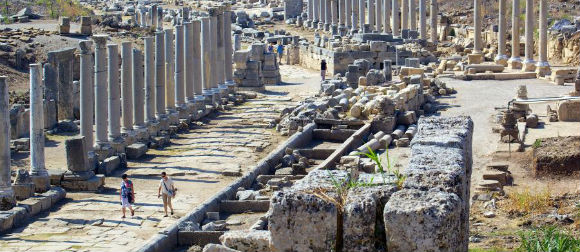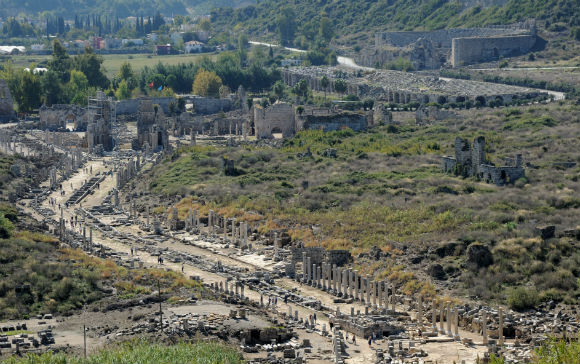The most impressive ruins of the Pamphylian coast are at Perge, at about 15 km east of Antalya. Perge was originally founded by the Hittites around 1500 BC. and was known as Parha. It was a successful trading centre near the Aksu (ancient Kestros or Cestrus) river when Alexander the Great arrived in 333 BC. He was welcomed in by the inhabitants and used Perge as base for his Anatolian campaigns. Alexander was followed by the Seleucids under whom the city prospered and Perge’s most celebrated inhabitant, the mathematician Apollonius from Perge lived and worked. Apollonius was a pupil of Archimedes and wrote a series of eight books on geometry. In 188 BC Perge became part of the Roman Empire during which the city flourished. Most of the surviving buildings date from this period.In 46 AD St. Paul started his journey in Perge (biblical Perga) and preached his first sermon here. Perge gradually declined during the Byzantine period, as the Aksu river silted, but remained inhabited until Selçuk times after which it became abandoned.
A visit to Perge starts by entering the archeological site through the Roman Gate, built during the reign of Septimius Severus (193-211 AD). Proceeding through the gate, to the right is the Agora or market place. This structure of 75 x 75 m dates back from the 2nd century AD. The center courtyard and shops were surrounded by a wide stoa, a covered walkway. The floor of the stoa and shops was made of colored mosaics. The agora was not only the centre of Perge’s trade, but was also a place for meetings as well as a forum for political, social, and philosophical discussions. The next building is the Hellenistic city gate that dates back to the 3rd century BC. This is certainly the most imposing building of the city and was cleverly designed to protect the city with its twin towers and its horseshoe-shaped courtyard at the back. It is thought that the towers had three floors and were crowned by a conical roof. In the year 121 AD, the horseshoe-shaped courtyard was rededesigned as a courtyard of honor. Behind the courtyard stood a triple arch. Around the arch there are about dozen inscriptions connected with Plancia Magna who lived in the 2nd century AD. She was the daughter of the governor, a priestess of Artemis Pergaia (Diana) and a benefactress to the city. Plancia Magna had the arch decorated with the statues of the emperors and their relatives.
After passing through the Hellenistic Gate and courtyard, one enters a broad, marble-paved double-colonnaded street measuring 300 meters in length that extends from the main gate to the acropolis. The street is 20 m wide and is divided in two by a 2 meter wide water channel running down the middle. At the end of the colonnaded street is the Nymphaeum, a triumphal fountain from where a stream flowed down into the water channel. The nymphaeum or nymphaion is an ornamental semicircular structure and dates from the reign of Emperor Hadrian (130-150 AD). A statue of a river god Kestros was located in the center of this huge fountain. Behind the nymphaeum is the acropolis with some remains of the Byzantine period. To the west of the nymphaeum are the remains of a palaestra dating from 50 AD and dedicated to the Emperor Cladius (41-54 AD).
Returning back to the entrance, there are the excavated Roman baths located southwest to the agora. Out of the site proper, is the horsehsoe-shaped stadium, the largest in Asia Minor, measuring 234 m by 34 m. The stadium had a seating capacity of 12,000 people supported by massive barrel-vaulted constructions. Just beyond the site entrance is also the theatre, which is of the Greco-Roman type and could seat 15,000 people. Unfortunately, it is for some time under reconstruction and unfortunately closed to visitors.
Perge,



You are given a most misleading map with no real idea of distances. The theatre is supposed to be the highlight and has explanatory notices and interesting artifacts but it is closed.The next best bit is the stadium which you can visit for free as it is outside the gates.Nice little shop..
Perge is fascinating and full of interesting stories but … among all of the other monuments surrounding Antalya it is the least "grandiose".
Part of a Thomas Cook tour, a good introduction to Roman archeaology
These are the most complete Roman ruins I have seen anywhere in the world. The theatre is under repair but everything else can be seen – the market place,the baths, the stadium, the high street and the water system that divided the town. Tread the stones where Alexander The Great and St Paul walked.
You don't need a taxi or…
Great ruins of ancients city including bathhouse, theatre (which is locked up )
marketplace. Etc. Worth the trip
We went as part of a tour taking in two other attractions which I will also review
We were given a lectur for maybe an hour or so in total giving background information when it was built and that kind of thing the guide was very informative we were then given half an hour of free time which was not…
Worth visiting if you like archaeological remains, plenty to see.
Good visit and lots to see there. Lots of ruins of Roman buildings still visible for what they had been as not been disturbed or stones redistributed as in England. Much more complete and gave a good insight into what had been there.
Perge is situated a little outside of Antalya and is a quite large site with various interesting sites to watch. When we arrived to Perge we passed the theater which unfortunately was closed to the public. We then came to the "city" itself which was large with a lot of interesting ruins. They had quite large public baths and a…
We arrived just a few minutes after opening time, and were already beaten by numerous tour buses! The site is very large and extends along the road as you get to the entrance to the site; not really any opportunities for parking along the road to take pictures, unfortunately. Perge is an active archeological excavation, and there are areas out…